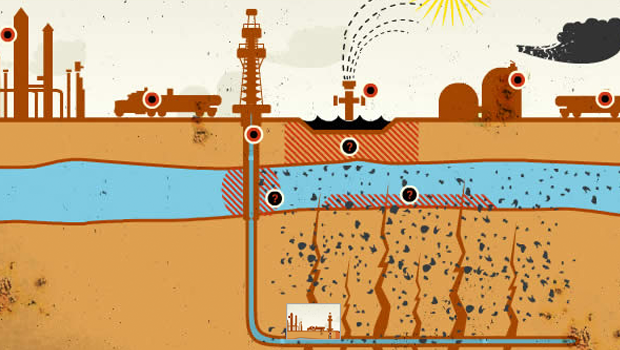
Fracking, otherwise known as hydraulic fracturing, is the process of cracking rocks by blasting them with high pressure liquids. Though the technique was first developed in the 1940s, fracking has become a major issue in the last few years as resources become more scarce, and the industry turns to more dramatic extraction methods like shale gas fracking.
Fracking is often described as the injection of fracking water into the ground, but fracking fluid composition is complex, and fracking fluids contain other additives and fracking chemicals. So just what is in so-called fracking water? There are a wide variety of fracking fluids used, depending on the local geology and the type of resource being extracted. For a more detailed look at what is in fracking fluids and on what the different fracking chemicals do, check out our [DEFINITION OF FRACKING FLUIDS].
Let’s continue with our gas and oil fracking definition.
Fracking technology has come a long way since the 1940s. Then, fluid could only be injected into pre-existing fractures in order to widen them. Nowadays, advances in engineeering and geophysics allow engineers to frack almost anywhere. This has led to a rapid expansion of fracking operations, with US fracking and UK fracking sites among the most controversial.
Fracking begins with the drilling of an initial borehole, along with horizontal shafts which can be up to 8,000 metres long. NExt, specialised fracking machinery is installed to pump, at incredible pressure, fluids into the hole. As the pressure in the borehole increases, tiny fractures and structural weaknesses in the surrounding rock are forced open, allowing deposits of oil, gas and other minerals to escape. These can then be extracted.
This process has been used for many years – in 2010, up to 60% of oil and gas wells were hydraulically fracked in order to maximise yields.
But what is shale gas fracking? Is that different?
Part of the reason for fracking’s huge rise in notoriety has been the emergence of shale gas fracking and shale oil fracking. Unlike traditional fracking, this process – sometimes called massive hydraulic fracking in shales – involves the large-scale fracturing of shale fields, which can result in huge natural gas and oil yields.
It is this type of fracking which is proving controversial with environmental groups, as the consequences of such massive geological fracturing are not fully understood.
Governments all over the world are weighing up the pros and cons of fracking, in order to balance the interests of environmental groups who oppose hydraulic shale gas fracking and the petroleum companies who advocate it.

Be the first to comment on "What the Frack? Read Our Fracking Definition"